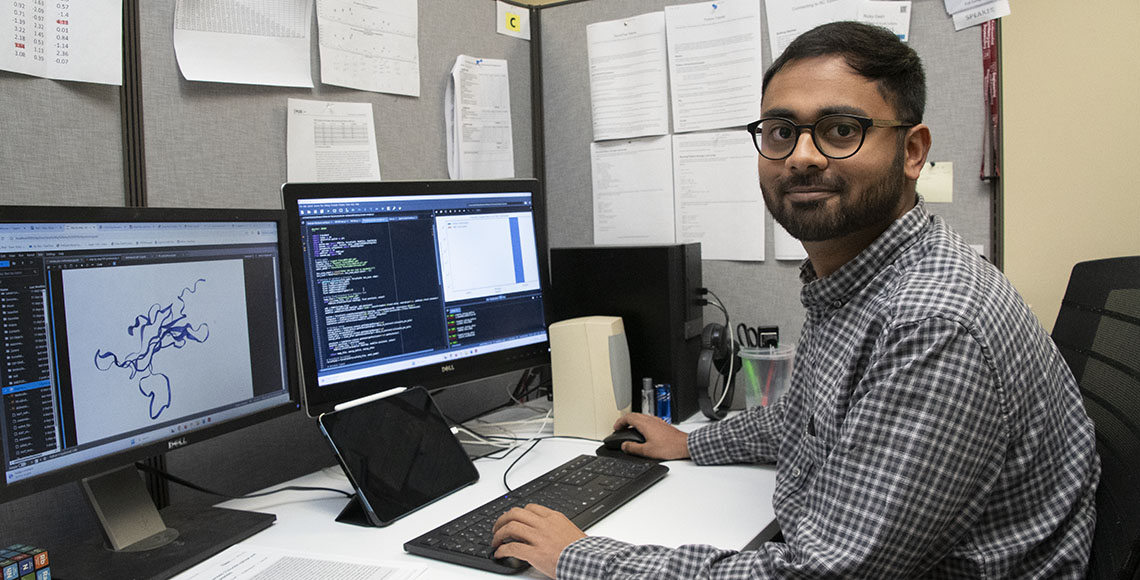Something clicked when chemical engineering Ph.D. student Ricky Dash first heard about the power of a distillation tower during an undergraduate lecture in India. It was not just the science that drew him in, it was the idea that chemical engineers quietly shape the world.
“I remember the instructor saying that a distillation tower is one of Earth's most impactful pieces of equipment,” Dash says. “From one tower, you can create a range of products for daily use, and that really stuck with me. I realized the field I had chosen is extremely impactful and has applications in almost every industry, from petroleum to pharmaceuticals and bone tissue engineering in hospitals.”
Originally from India, Dash completed his undergraduate degree in chemical engineering at the Indian Institute of Technology Hyderabad before moving to the U.S. to pursue his Ph.D. at the University of South Carolina. Now, he is working at the intersection of biomedical science and artificial intelligence, using machine learning to help improve treatments for osteoporosis.
Dash’s research centers on finding a safer, more targeted way to promote bone regeneration. Traditional approaches often involve using bone morphogenetic proteins (BMPs), but these treatments come with unpredictable and sometimes harmful side effects.
“In a healthy body, stem cells receive a signal from BMPs which tells them to become bone cells,” Dash says. “As we age, that protein isn’t produced as much and bone density decreases. Some treatments try to fix this by implanting a graft with the protein, but proteins are highly reactive and can diffuse to other parts of the body. There have even been reports of unintended bone growth in areas like the neck.”
Instead of using full proteins, Dash is developing shorter peptides. These chains of amino acids mimic the function of BMPs but are less likely to cause side effects. To design and test these peptides, he uses computational modeling and machine learning.
“Peptides are smaller and have fewer active sites,” Dash says. “My work focuses on designing a peptide that’s safer but still effective. I use modeling tools and machine learning algorithms to predict how these peptides will behave and interact with the body.”
Dash had no background in computational modeling when he arrived at USC. But his advisor, Biomedical Engineering Professor Esmaiel Jabbari, encouraged him to embrace it anyway — a decision that brought some early challenges.
“I used one modeling system for more than a year, and it wasn’t working,” Dash says. “At one point, it predicted that alcohol doesn’t dissolve in water, which isn’t right. I was frustrated and almost ready to give up. But eventually, I found a small error in the way the model was set up. That discovery led to a new model and my first publication as a first author.”
That paper marked a major milestone for Dash, who also serves as a teaching assistant and mentors undergraduate students. He has helped design class projects that introduce students to molecular modeling, protein structures and even their first experience with coding.
“I tell students that coding is just another language,” Dash says. “Just like how we speak English or Spanish, coding is how you speak to a computer. I want them to see how you can extract biological meaning from structure data, like how a protein folds and how that affects what it does in the body.”
Dash’s research and presentations have already earned him awards, but for him, the biggest reward is the confidence that recognition brings.
“In a Ph.D. program, there’s a lot of failure. You question yourself constantly,” Dash says. “These recognitions help me feel that maybe I do belong here. Maybe I am cut out for this.”
Although he briefly considered industry, Dash says his heart is in academia.
“I like doing deep, thoughtful research. In industry, it’s more about meeting deadlines and market goals,” Dash says. “ I’ve spent so much time developing my teaching skills and learned how to explain complex ideas to students who might be hearing them for the first time. That’s something I value and want to continue doing.”
Outside of the lab, Dash stays grounded through sports, gym sessions and spending time with friends. A former member of his undergraduate basketball and theater clubs, he still plays sports such as basketball, soccer and badminton.
“I’ve always stayed active; it helps me reset after long days in the lab,” Dash says. “I also have this habit of watching TV shows or live sports while I eat. It’s something I’ve done since undergrad. It helps me relax and avoid burnout.”
And while he doesn’t make them as often anymore, Dash once had a reputation among his friends for creating personalized memes featuring professors and classmates.
“It was my way of letting off steam,” Dash says. “I used to take a scene from a movie or TV show and Photoshop faces onto it. Everyone could relate and laugh, and it was a fun way to bring people together.”
As he looks ahead to life after graduation, Dash says he is excited about what comes next and the role he hopes to play in the next generation of engineers.
“Being a professor is about more than research,” Dash says. “It’s about helping students think differently and grow.”
